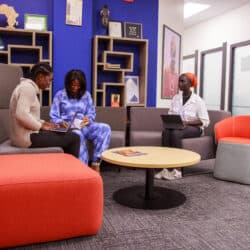What should organizations with underused office spaces do? Is the pre-pandemic hum necessary, and if yes, how can this vibrancy happen when workers are not in shared workspaces? What will happen if staff do not feel engaged? Contributor Yvonne Rodney talked to leaders from one collective that has tackled the empty-office problem about what they have learned.
The previous installment of the Work in Progress series looked at the nature of work and some of the tensions with which organizations are grappling. Now we examine the role of the office and how the topic connects to vibrancy and doing our best work.
Post-pandemic offices are emptier. Buildings once filled with workers are eerily quiet. In some organizations, managers have offered shift options that minimize risk but bring workers back to the office – Monday, Tuesday, and Wednesday this week, and Wednesday, Thursday, and Friday the following week, allowing for an overlap day. In other agencies, there is no overlap: employees choose which day they will come in or if they come in at all.
But the former hum, vibrancy, and liveliness is missing. What does this lack of vibrancy mean? Is the hum necessary, and if yes, necessary for what?
Is the hum necessary, and if yes, necessary for what?
We now know that we do not have to be in the office to be productive. For some, productivity improved working from home. A BBC article written in 2021, while the pandemic was still in full sway, questioned the role of the office and whether we still need it. So, what should organizational leaders with underused office spaces do? Do they move, downsize, or renegotiate their lease agreements? Should they hang on to the space in case workers want to return one day?
Let’s look at an example of how one collective tackled the empty-office problem and what they learned as a result.
Foundation House is a co-location shared space for advancing Canadian philanthropy and is home to 12 distinct organizations. (Note: none of these organizations offer direct services to the public.) The space – which was intentionally designed to foster collaboration, engagement, and community with like-minded tenants and had done that exceptionally well prior to the pandemic – is now much emptier. In the latter part of 2022, the Foundation House senior leadership team decided to do something about the problem and engaged a “design thinking” consultant.
Design thinking seeks to explore situations based on people’s interests, wishes, and needs and uses an interactive, participatory method of generating ideas and translating these into product possibilities.
Cameron Norman, Cense
“Design thinking,” says Cameron Norman, principal and president of strategic design company Cense and facilitator of the Foundation House rethinking project, “seeks to explore situations based on people’s interests, wishes, and needs and uses an interactive, participatory method of generating ideas and translating these into product possibilities.”
Because space is a big investment, Norman advises leaders grappling with the underused-space problem to start the discussion with the following questions:
- How does the space we work in allow us to do what we do better?
- What are we all about?
- What is it that we, by coming together, do that we can’t or won’t do otherwise?
- How do we help our staff to be better at what we do?
Through workshops, confidential surveys, consultations, and interviews with staff and tenant organization leaders, Norman helped Foundation House gather critical information to move forward. Here’s what they learned.
Foundation House’s tenants, those working virtually and those who worked in the office, valued and wanted interaction and collaboration with each other to continue. They wanted opportunities to learn and felt that the office space could foster that through information sharing, professional development, or other learning forums. In addition, the tenants are willing to look at expansion or opening of the space to other groups as a possible solution to the underuse issue. The design-thinking process also revealed potential barriers to in-office reengagement, including transportation, commuting, safety protocols, and availability of private space to have online meetings.
Tackling the space problem helped Foundation House tenants clarify what they want: opportunities for interaction, collaboration, and professional development. They wanted to feel vibrant again.
How Foundation House tenants will actualize the learning is still being examined. Tackling the space problem, however, helped them clarify what they want: opportunities for interaction, collaboration, and professional development. They wanted to feel vibrant again.
But if workers are not in shared workspaces, if they are in the office sometimes or working different days, how can this vibrancy happen? How do leaders help staff feel a sense of community and belonging within their organization when staff are not together in person? What will happen if staff do not feel engaged? What fosters engagement? How important is org culture? And what is it that workers need to do their best work?
Three senior leaders of Foundation House shared their perspectives and learning around the space issue. Their views reflect how closely intertwined space is with the issue of doing one’s best work and keeping vibrant.
Collusion of people sparks ideas
Bruce Lawson, special advisor to The Counselling Foundation of Canada, says he is much more productive at the office than when working from home. He misses the previous vibrancy, camaraderie, and collaboration among the various teams. “The collusion of people sparks ideas,” he says. “Conversations are easier, richer, and faster in person. Colleagues in close physical proximity allow you to think out loud in their presence. It’s harder to express random thoughts when you have to pick up the phone or schedule a meeting.”
The collusion of people sparks ideas. Conversations are easier, richer, and faster in person.
Bruce Lawson, Counselling Foundation of Canada
Lawson is a perfect example of a person who thrives in a lively, populated workspace. He says that Foundation House was intentionally designed, and like-minded tenants selected, for the beauty that can come from cross-collaboration. And while he would love to see Foundation House return to its pre-pandemic hum, he knows it must not be mandated. “People need to see a personal benefit from showing up and engaging. Each organization needs to make that value proposition.”
There is value in coming together
Kay Castelle, executive director of the Career Education & Research Institute for Counselling (CERIC), joined the Foundation House team in January 2023. She has no history of working with the tenants in that space. For her, the space discussion is not just about the physical space; it’s also about how we repurpose workspaces for the future. She sees a parallel between the transformations taking place now in how society is viewing work and the way things shifted during and after the Industrial Revolution. Essentially, what people want in and from careers has changed significantly post-pandemic. The challenge for leaders is how to balance the unique contextual needs of each staff member with employer expectations.
As we navigate through [these] unprecedented times, there’s significant value in critically assessing the benefits and disadvantages of different work models.
Kay Castelle, CERIC
Castelle poses some reflective questions about the staff-working-together-in-the-same-space issue: “Is what we are hanging on to pure nostalgia, or is it critical for career building? How do we move beyond what we are etched in to adequately address what’s happening right now? How do we create and maintain consistent policies for everyone, whether they work in the office or remotely? What is not viable anymore? What has been lost?”
There is no easy way to go back to what was, she notes. “As we navigate through [these] unprecedented times, there’s significant value in critically assessing the benefits and disadvantages of different work models.” Castelle sees the need for a middle ground where staff have opportunities for community building and collaboration, whether working virtually or in person.
We can all own the future
Riz Ibrahim, president and CEO of The Counselling Foundation of Canada, leans back in his chair and considers the question about what he’s learned from the design-thinking process. “Where we are is not where we’re going to be,” he says, almost as a reminder to release the past. For him, the pandemic disrupted things taken for granted about how we worked: the five-day workweek, easy access to colleagues on any given workday, conversations that sparked naturally, and the collaborations that resulted. And the food – sharing over lunches, building alliances, and getting to know people.
Where we are is not where we’re going to be … We are not going to use space like before. And that’s OK.
Riz Ibrahim, Counselling Foundation of Canada
Ibrahim notes that while pre-pandemic occupants of Foundation House can name what they miss of those “glory” days, staff members hired during the pandemic do not know what they never had. To underscore this point, he notes that between 40 and 50% of current staff do not own the past that he knew – but, he says optimistically, “we can all own the future.” For him the next logical step is to make sure collaboration happens between people working virtually and those in the office and that all staff feel a sense of belonging and community.
So his advice to others on the topic of repurposing space is based on his own coming to terms:
- We are not going to use space like before. And that’s OK.
- The design thinking gave us permission to think more broadly – to explore other opportunities for use of our space.
- More investigation and coordination is required to fully investigate any option.
- We are still in the flux phase – therefore, hold loosely to ideas while ensuring that mission remains central to any decisions about space.
There you have it. Three leaders, nostalgia aside, choosing to own a future where collaboration and engagement happen. The square footage of the physical offices may have to be repurposed. Staff may not all be in on the same days, and some may work in a different place altogether. But all agree on the value and necessity of team building and the benefits that come from collective sharing. It fosters personal and organizational vibrancy. To them, this is one element that is critical to retain, foster, and fight for.
Empty spaces can always be repurposed, but keeping organization, mission, and staff well-being central to every decision about space is critical. To quote Norman, “The space does not care.” But care communities do!
Discussion questions for readers
- What are your views on the space issue?
- What are the pros and cons of virtual versus in-office working?
- What would you suggest in terms of policies that would be fair and consistent for those working remotely (in another country or province) and those working in-office?
- What activities would be worth doing in person with your work colleagues?
- What advice would you give to leaders on what to do with the underused office space?
If you have thoughts, we want to hear from you. Please email us at info@thephilanthropist.ca or connect with us on social media at @Phil_journal.
The Work in Progress series is being developed in collaboration with the following content development partners: the Future Skills Centre, the Counselling Foundation of Canada, CERIC, Imagine Canada, the Ontario Nonprofit Network, and the Workforce Funder Collaborative.


